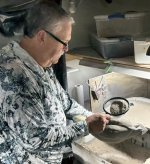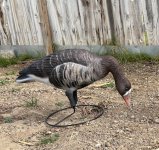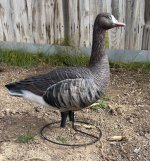Don recommends 3% hydrogen peroxide for blood removal. Maybe this? it does say hydrogen peroxide does help get rid of calcium buildup on most surfacesI wouldn't hunt if I couldn't hunt over my custom double flocked Speck decoys....
All thanks to Don Mintz and his generous sharing of valuable information.
Yesterday was a prime example. Limits of Specks for my blind partner and I. Cupped and webbed to say the least. No other shots heard in the north Sacto. Valley. Generally poor Opener for most hunters in our area.
We hunt in very "hard" water. Lots of calcium. Some dekes always manage to fall over. When straightened up and dried out, there is a heavy, visible, white calcium line that adheres to the flocking. I hate it. Any thoughts on how to remove this? I was thinking a vinegar rinse might do the trick, but, I don't want to disrupt the enamel Rustoleum glue. Thanks
( Photo taken before deployment)
You are using an out of date browser. It may not display this or other websites correctly.
You should upgrade or use an alternative browser.
You should upgrade or use an alternative browser.
All Things Flocking
- Thread starter Don Mintz
- Start date
you may need to play around with a single decoy. I've heard oxyclean is good, but haven't tried it myself. We have lots of issues with moss leaving a ring around the bottom of decoys here on the snake river. I've never done much more than spray them off in my shop sink with hot water. We might just need to see what kinds of things work and what won't.
I put flocking on 40 decoys this morning by noon, some full coats, some second coats like the chest of a mallard drake. This is a photo of my high tech flocking set up. A kitchen sieve and a plastic tub, of course normally I'd be covered up with a respirator and goggles. The fishing shirt is good to cover everything so I don't have to drag it all back in the house. This is my carving and airbrushing exhaust booth. I've used everything as far as applicators and nothing works better than this simple operation. Puffer bottles have to be constantly reloaded as well as the air assist gun, not to mention they blow flocking all over the shop, been there, done that. I have one tub slightly higher than the one I'm working out of. I lay the lid upside down and let it overhang the tub in order to catch some of the drifting flocking.


As far as high tech, at one point we had designed a flocking booth that would have shortened the dusting process and contain the flocking much better, but once I moved my shop back home I didn't have the space. The big deal with flocking is painting the glue on, that's what takes time and there is no way around it. Two people can flock a hundred decoys a day, one color. Caleb and I would both paint on the rustoleum and I would flock both his and mine. He would paint 3 decoys to every one that I would paint, then I'd flock till I caught up and then paint again. First coats, especially in the summer need to go quickly so the paint doesn't tack up. Second coats are much more forgiving, rustoleum gloss stays sticky for a long time and on second coats I frequently will paint over a first coat in preparation for the second and sit it aside till I get the next one done and swap them out. That allows the paint to absorb better and even out, resulting in a much more uniform second coat. Probably the biggest deal is shelf space, 100 decoys at a time take up a lot of space, most flocking jobs are 3 and four colors, one day each color. It can get pretty crowded
've forgotten a last decoy in line a couple of times after I painted on the second coat of rustoleum, one time it was nearly an hour, it was still very wet, so I flocked it and it worked just fine. That won't work on a first coat.
Single coats don't wear very well. I'm working on a bunch of tanglefree mallards right now and the heads are factory flocked, well not really, it's more like a powder than flocking. At any rate most of the first coat has worn off, but does have a decent base of fuzzy still attached and I'm going to at least try getting my second coat to finish the job, we will see.
you have to wrap your mind around using gloss paint, both for flocking and through the airbrush. For flocking it is to make better adhesion with it's longer drying time, for airbrush to both remain compatible with the glue and using gloss over flocking through the airbrush doesn't make it glossy and is more durable. Any time you add flatteners to paint it weakens it. Even when painting gloss black over dark areas for contrast, it is blacker than painting flat black. The only flat paint we use is when painting un flocked decoys. It's good that gloss works, when dealing with rustoleum, there aren't many choices in flat colors anyway.
We recently painted a couple of non flocked specks. The flat black just wasn't looking black enough, so we painted over the flat black bars with gloss black with a technique we call hazing. Hazing is several light passes to make a color richer without making it glossy. It ends up a bit less glossy than satin black. It was a customer request that we didn't put the light barring on the back of these canada to speck conversions, not my idea. They wanted them dark,


've forgotten a last decoy in line a couple of times after I painted on the second coat of rustoleum, one time it was nearly an hour, it was still very wet, so I flocked it and it worked just fine. That won't work on a first coat.
Single coats don't wear very well. I'm working on a bunch of tanglefree mallards right now and the heads are factory flocked, well not really, it's more like a powder than flocking. At any rate most of the first coat has worn off, but does have a decent base of fuzzy still attached and I'm going to at least try getting my second coat to finish the job, we will see.
you have to wrap your mind around using gloss paint, both for flocking and through the airbrush. For flocking it is to make better adhesion with it's longer drying time, for airbrush to both remain compatible with the glue and using gloss over flocking through the airbrush doesn't make it glossy and is more durable. Any time you add flatteners to paint it weakens it. Even when painting gloss black over dark areas for contrast, it is blacker than painting flat black. The only flat paint we use is when painting un flocked decoys. It's good that gloss works, when dealing with rustoleum, there aren't many choices in flat colors anyway.
We recently painted a couple of non flocked specks. The flat black just wasn't looking black enough, so we painted over the flat black bars with gloss black with a technique we call hazing. Hazing is several light passes to make a color richer without making it glossy. It ends up a bit less glossy than satin black. It was a customer request that we didn't put the light barring on the back of these canada to speck conversions, not my idea. They wanted them dark,


